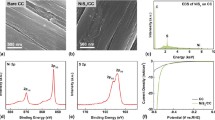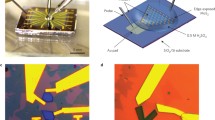Abstract
Developing excellent electrocatalysts is a significant step in accelerating the widespread implementation of the electrochemical hydrogen evolution reaction (HER). MoS2 is one of the promising alternatives to platinum-based catalysts, while its HER activity is far from Pt due to the lack of active sites. It is urgent to develop a novel strategy to activate the basal planes of MoS2 for enhancing the HER activity. Herein, a facile hydrothermal method with a low-temperature H2O2 etching method is developed to fabricate MoS2 with O-doped and S-vacancy dual defects. The dual defects MoS2 nanosheet demonstrates remarkable hydrogen evolution reaction (HER) activity, achieving 10 mA cm−2 with a small overpotential of around 143 mV in 0.5 M H2SO4.
Graphical Abstract

Construct dual-defect MoS2 via a facile hydrothermal method and mild H2O2 etching process.






Similar content being viewed by others
Availability of Data and Materials
All data that support the findings of this study are included within the article (and any supplementary files).
References
O.J. Guerra, J. Eichman, J. Kurtz, B.M. Hodge, Cost competitiveness of electrolytic hydrogen. Joule. 3, 2425–2443 (2019). https://doi.org/10.1016/j.joule.2019.07.006
J. Kibsgaard, I. Chorkendorff, Considerations for the scaling-up of water splitting catalysts. Nat. Energy 4, 430–433 (2019). https://doi.org/10.1038/s41560-019-0407-1
J. Linnemann, K. Kanokkanchana, K. Tschulik, design strategies for electrocatalysts from an electrochemist’s perspective. ACS Catal. 11, 5318–5346 (2021). https://doi.org/10.1021/acscatal.0c04118
J. Song, C. Wei, Z.F. Huang, C. Liu, L. Zeng, X. Wang, Z.J. Xu, A review on fundamentals for designing oxygen evolution electrocatalysts. Chem. Soc. Rev. 49, 2196–2214 (2020). https://doi.org/10.1039/c9cs00607a
S. Anantharaj, V. Aravindan, Developments and perspectives in 3D transition-metal-based electrocatalysts for neutral and near-neutral water electrolysis. Adv. Energy Mater. 10, 1–30 (2020). https://doi.org/10.1002/aenm.201902666
T.F. Jaramillo, K.P. Jørgensen, J. Bonde, J.H. Nielsen, S. Horch, I. Chorkendorff, Identification of active edge sites for electrochemical H2 evolution from MoS2 nanocatalysts. Science 317, 100–102 (2007). https://doi.org/10.1126/science.1141483
Y. Yin, J. Han, Y. Zhang, X. Zhang, P. Xu, Q. Yuan, L. Samad, X. Wang, Y. Wang, Z. Zhang, P. Zhang, X. Cao, B. Song, S. Jin, Contributions of phase, sulfur vacancies, and edges to the hydrogen evolution reaction catalytic activity of porous molybdenum disulfide nanosheets. J. Am. Chem. Soc. 138, 7965–7972 (2016). https://doi.org/10.1021/jacs.6b03714
H. Li, C. Tsai, A.L. Koh, L. Cai, A.W. Contryman, A.H. Fragapane, J. Zhao, H.S. Han, H.C. Manoharan, F. Abild-pedersen, J.K. Nørskov, Activating and optimizing MoS2 basal planes for hydrogen evolution through the formation of strained sulphur vacancies. Nat. Mater. 15, 48–53 (2016). https://doi.org/10.1038/nmat4564
X. Hou, H. Zhou, M. Zhao, Y. Cai, Q. Wei, MoS2 nanoplates embedded in Co-N-doped carbon nanocages as efficient catalyst for HER and OER. ACS Sustain. Chem. Eng. 8, 5724–5733 (2020). https://doi.org/10.1021/acssuschemeng.0c00810
D. Kong, H. Wang, J.J. Cha, M. Pasta, K.J. Koski, J. Yao, Y. Cui, Synthesis of MoS2 and MoSe2 films with vertically aligned layers. Nano Lett. 13, 1341–1347 (2013). https://doi.org/10.1021/nl400258t
J. Feng, Z. Zhao, R. Tang, Y. Zhao, T. Meng, Interfacial structural and electronic regulation of MoS2 for promoting its kinetics and activity of alkaline hydrogen evolution. ACS Appl. Mater. Interfaces 13, 53262–55327 (2021). https://doi.org/10.1021/acsami.1c17031
Y. Zhou, Y. Liu, W. Zhao, F. Xie, R. Xu, B. Li, X. Zhou, H. Shen, Growth of vertically aligned MoS2 nanosheets on a Ti substrate through a self-supported bonding interface for high-performance lithium-ion batteries a general approach. J. Mater. Chem. A Mater. 4, 5932–5941 (2016). https://doi.org/10.1039/c6ta01116k
J. Rong, Y. Ye, J. Cao, X. Liu, H. Fan, S. Yang, M. Wei, L. Yang, J. Yang, Y. Chen, Restructuring electronic structure via W doped 1T MoS2 for enhancing hydrogen evolution reaction. Appl. Surf. Sci. 579, 152216–152224 (2021). https://doi.org/10.1016/j.apsusc.2021.152216
X. Chen, Z. Wang, Y. Wei, X. Zhang, Q. Zhang, L. Gu, L. Zhang, N. Yang, R. Yu, High phase-purity 1T-MoS2 ultrathin nanosheets by a spatially confined template. Angew. Chem. Int. Ed. 58, 17621–17624 (2019). https://doi.org/10.1002/anie.201909879
L. Wang, X. Zhang, Y. Xu, C. Li, W. Liu, S. Yi, K. Wang, X. Sun, Z.S. Wu, Y. Ma, Tetrabutylammonium-intercalated 1T-MoS2 nanosheets with expanded interlayer spacing vertically coupled on 2D delaminated MXene for high-performance lithium-ion capacitors. Adv. Funct. Mater. 31, 1–11 (2021). https://doi.org/10.1002/adfm.202104286
R. Zhang, M. Zhang, H. Yang, G. Li, S. Xing, M. Li, Y. Xu, Q. Zhang, S. Hu, H. Liao, Y. Cao, Creating fluorine-doped MoS2 edge electrodes with enhanced hydrogen evolution activity, Small. Methods 5, 1–7 (2021). https://doi.org/10.1002/smtd.202100612
Y. Shi, Y. Zhou, D.R. Yang, W.X. Xu, C. Wang, F. Bin Wang, J.J. Xu, X.H. Xia, H.Y. Chen, Energy level engineering of MoS2 by transition-metal doping for accelerating hydrogen evolution reaction, J. Am. Chem. Soc. 139, 15479–15485 (2017). https://doi.org/10.1021/jacs.7b08881
X. Yang, X. Li, Y. Wang, C. Ye, Z. Du, H. Yu, J. Liu, L. Chen, B. Su, Efficient etching of oxygen-incorporated molybdenum disulfide nanosheet arrays for excellent electrocatalytic hydrogen evolution. Appl. Surf. Sci. 491, 245–255 (2019). https://doi.org/10.1016/j.apsusc.2019.06.153
J. Xie, J. Zhang, S. Li, F. Grote, X. Zhang, H. Zhang, R. Wang, Y. Lei, B. Pan, Y. Xie, Controllable disorder engineering in oxygen-incorporated MoS2 ultrathin nanosheets for efficient hydrogen evolution. J. Am. Chem. Soc. 135, 17881–17888 (2013). https://doi.org/10.1021/ja408329q
X.-Y. Li, S.-J. Zhu, Y.-L. Wang, T. Lian, X. Yang, C.-F. Ye, Y. Li, B.-L. Su, L.-H. Chen, Synergistic regulation of S-vacancy of MoS2-based materials for highly efficient electrocatalytic hydrogen evolution. Front. Chem. 10, 1–17 (2022). https://doi.org/10.3389/fchem.2022.915468
T. Lian, X. Li, Y. Wang, S. Zhu, X. Yang, Z. Liu, C. Ye, J. Liu, Y. Li, B. Su, L. Chen, Boosting highly active exposed Mo atoms by fine-tuning S-vacancies of MoS2-based materials for efficient hydrogen evolution. ACS Appl. Mater. Interfaces 14, 30746–30759 (2022). https://doi.org/10.1021/acsami.2c05444
X. Wang, Y.Y. Zhang, H. Si, Q. Zhang, J. Wu, L. Gao, X. Wei, Y. Sun, Q. Liao, Z. Zhang, K. Ammarah, L. Gu, Z. Kang, Y.Y. Zhang, Single-atom vacancy defect to trigger high-efficiency hydrogen evolution of MoS2. J. Am. Chem. Soc. 142, 4298–4308 (2020). https://doi.org/10.1021/jacs.9b12113
S. Park, J. Park, H. Abroshan, L. Zhang, J.K. Kim, J. Zhang, J. Guo, S. Siahrostami, X. Zheng, Enhancing catalytic activity of MoS2 basal plane S-vacancy by co cluster addition. ACS Energy Lett. 3, 2685–2693 (2018). https://doi.org/10.1021/acsenergylett.8b01567
C.C. Cheng, A.Y. Lu, C.C. Tseng, X. Yang, M.N. Hedhili, M.C. Chen, K.H. Wei, L.J. Li, Activating basal-plane catalytic activity of two-dimensional MoS2 monolayer with remote hydrogen plasma. Nano Energy 30, 846–852 (2016). https://doi.org/10.1016/j.nanoen.2016.09.010
L. Li, Z. Qin, L. Ries, S. Hong, T. Michel, J. Yang, C. Salameh, M. Bechelany, P. Miele, D. Kaplan, D. Voiry, M. Chhowalla, D. Voiry, Role of sulfur vacancies and undercoordinated mo regions in MoS2 nanosheets toward the evolution of hydrogen. ACS Nano 13, 6824–6834 (2019). https://doi.org/10.1021/acsnano.9b01583
C. Tsai, H. Li, S. Park, J. Park, H.S. Han, J.K. Nørskov, X. Zheng, F. Abild-pedersen, Electrochemical generation of sulfur vacancies in the basal plane of MoS2 for hydrogen evolution. Nat. Commun. 8, 1–8 (2017). https://doi.org/10.1038/ncomms15113
P. Zhang, H. Xiang, L. Tao, H. Dong, Y. Zhou, T.S. Hu, X. Chen, S. Liu, S. Wang, S. Garaj, Chemically activated MoS2 for efficient hydrogen poduction. Nano Energy 57, 535–541 (2019). https://doi.org/10.1016/j.nanoen.2018.12.045
M. Wu, J. Liao, L. Yu, R. Lv, P. Li, W. Sun, R. Tan, X. Duan, L. Zhang, F. Li, J. Kim, K.H. Shin, H. Seok Park, W. Zhang, Z. Guo, H. Wang, Y. Tang, G. Gorgolis, C. Galiotis, J. Ma, Roadmap on carbon materials for energy storage and conversion. Chem. Asian J. 15(2020), 995–1013 (2020). https://doi.org/10.1002/asia.201901802
X. Chen, B. Put, A. Sagara, K. Gandrud, M. Murata, J.A. Steele, H. Yabe, T. Hantschel, M. Roeffaers, M. Tomiyama, H. Arase, Y. Kaneko, M. Shimada, M. Mees, P.M. Vereecken, Silica gel solid nanocomposite electrolytes with interfacial conductivity promotion exceeding the bulk li-ion conductivity of the ionic liquid electrolyte filler, Sci. Adv. 6, (2020). https://doi.org/10.1126/sciadv.aav3400
J. Xu, G. Shao, X. Tang, F. Lv, H. Xiang, C. Jing, S. Liu, S. Dai, Y. Li, J. Luo, Z. Zhou, Frenkel-defected monolayer MoS2 catalysts for efficient hydrogen evolution. Nat. Commun. 13, 2193–2201 (2022). https://doi.org/10.1038/s41467-022-29929-7
Y. Zheng, T. Zhou, C. Zhang, J. Mao, H. Liu, Z. Guo, boosted charge transfer in SnS/SnO2 heterostructures: toward high rate capability for sodium-ion batteries. Angew. Chem. Int. Ed. 55, 3408–3413 (2016). https://doi.org/10.1002/anie.201510978
Y. Wan, Z. Zhang, X. Xu, Z. Zhang, P. Li, X. Fang, K. Zhang, K. Yuan, K. Liu, G. Ran, Y. Li, Y. Ye, L. Dai, Engineering active edge sites of fractal-shaped single-layer MoS2 catalysts for high-efficiency hydrogen evolution. Nano Energy 51, 786–792 (2018). https://doi.org/10.1016/j.nanoen.2018.02.027
J. Lin, S. Zuluaga, P. Yu, Z. Liu, S.T. Pantelides, K. Suenaga, Novel Pd2Se3 two-dimensional phase driven by interlayer fusion in layered PdSe2. Phys. Rev. Lett. 119, 1700–1701 (2017). https://doi.org/10.1103/PhysRevLett.119.016101
Y. Dong, B. Zeng, J. Xiao, X. Zhang, D. Li, M. Li, J. He, M. Long, Effect of sulphur vacancy and interlayer interaction on the electronic structure and spin splitting of bilayer MoS2. J. Phys. Condens. Matter 30, 125302 (2018). https://doi.org/10.1088/1361-648X/aaad3b
X. Zhang, S. Wang, C.-K. Lee, C.-M. Cheng, J.-C. Lan, X. Li, J. Qiao, X. Tao, Unravelling the effect of sulfur vacancies on the electronic structure of the MoS2 crystal. Phys. Chem. Chem. Phys. 22, 21776–21783 (2020). https://doi.org/10.1039/C9CP07004D
Funding
This article received support from key projects of the Anhui Provincial Department of Education, China (Grant No. KJ2021ZD0044), the University Natural Science Research Project of Anhui Province (KJ2021A0380), and the Anhui Provincial Natural Science Foundation (1908085QE179, 2208085ME110).
Author information
Authors and Affiliations
Contributions
Jianmin Wang: conceptualization, methodology, visualization, formal analysis, writing – original draft, investigation, data curation. Hongyu Zhao and Hao Zhang: software, visualization. Ruoyu Huang: investigation, data curation. Jiajia Cai: formal analysis.Jing Hu: formal analysis, resources. Zhijie Chen: formal analysis. Yongtao Lig: writing – review & editing, funding acquisition, supervision. Haijin Li: writing – review & editing, funding acquisition, supervision, project administration.
Corresponding authors
Ethics declarations
Ethical Approval
All procedures performed in studies involving human participants were by the ethical standards of the institutional and/or national research committee and with the 1964 Helsinki Declaration and its later amendments or comparable ethical standards.
Conflict of Interest
The authors declare no competing interests.
Additional information
Publisher's Note
Springer Nature remains neutral with regard to jurisdictional claims in published maps and institutional affiliations.
Supplementary Information
Below is the link to the electronic supplementary material.
Rights and permissions
Springer Nature or its licensor (e.g. a society or other partner) holds exclusive rights to this article under a publishing agreement with the author(s) or other rightsholder(s); author self-archiving of the accepted manuscript version of this article is solely governed by the terms of such publishing agreement and applicable law.
About this article
Cite this article
Zhao, H., Zhang, H., Huang, R. et al. Fabrication of MoS2 with Dual Defects of O-Doping and S-Vacancies for High-Efficiency Hydrogen Production. Electrocatalysis 15, 20–28 (2024). https://doi.org/10.1007/s12678-023-00850-x
Accepted:
Published:
Issue Date:
DOI: https://doi.org/10.1007/s12678-023-00850-x




